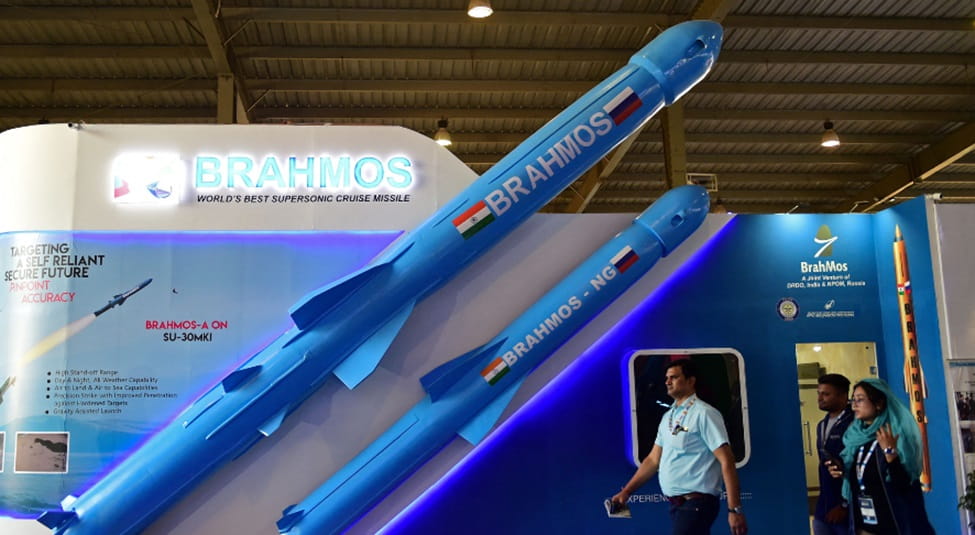
India’s BrahMos missile on display | Viraj Solanki/IISS

India’s recent delivery of BrahMos missiles to the Philippines – the first batch of its most valuable defence-export deal to date – is part of a broader effort by New Delhi to step up defence engagement with Southeast Asian states.
On 19 April, India delivered BrahMos missiles to the Philippines – the first batch of a US$375 million deal with Manila that will see New Delhi provide three batteries of the cruise missile to the Philippine Marine Corps. The agreement constitutes India’s most valuable defence-export deal to date. It is further indication that following the India–China border clashes of June 2020, New Delhi is seeking to engage more closely with China’s neighbours on regional defence and security issues to counter the latter’s influence – where previously it was more hesitant to do so for fear of antagonising Beijing.
India’s greater willingness to engage Southeast Asian states is in part the result of growing India–China competition. The border clashes in 2020 widened the trust deficit between New Delhi and Beijing and added to the geopolitical polarisation of South and Southeast Asia. India has become increasingly concerned that a China-dominated Southeast Asia could pose a greater challenge for India than previously anticipated.
As a result, New Delhi is wary of Beijing’s growing regional presence and influence, including its activities in the South China Sea and the potential impact of those activities on India’s freedom of navigation. As a result, India has become less willing to cater to China’s sensitivities with respect to engaging its neighbours.
An additional consideration for the Indian government is the substantial scope for greater India–Southeast Asia cooperation and defence engagement. Following the success of the BrahMos deal with the Philippines, India views the region as a more viable market for its arms exports. Along with defence exports, India has stepped up its defence engagement with the Association of Southeast Asian Nations (ASEAN) to demonstrate that it wants to engage with all countries in the region.
India faces several challenges, however, in trying to become a more reliable defence and security partner for the region: questions remain over its ability to meaningfully enter the regional arms market (and demonstrate that its equipment is better than that of the region’s traditional arms partners, China and Russia), as well as the extent to which it will be able to enhance its military presence in Southeast Asia – including through resources and capacity, such as increased military deployments to the region – given the Indian Ocean remains New Delhi’s priority.
India’s Defence Exports
Before the 2022 deal with the Philippines – New Delhi’s first major defence-export deal – India had made limited arms sales to Southeast Asian countries. In recent years, India has sought to increase defence exports to the region to provide states with an alternative to Chinese and Russian equipment. Separate to the 2022 deal, the Philippine Army has also selected the BrahMos coastal-defence missile and plans to buy two batteries.
To prioritise its arms sales, India will shortly send a defence attaché to its embassy in the Philippines. New Delhi will then have a resident or non-resident defence attaché – tasked with boosting India’s regional defence cooperation – in all ASEAN states except Cambodia and Laos.
Since the 2022 deal with the Philippines, however, India has not finalised sales of BrahMos (or any other defence equipment) to any Southeast Asian countries. India has tried to sell the missile to Indonesia, Thailand and Vietnam but no agreements have been finalised. The lack of sales highlights the challenge India faces in trying to break into the regional arms market. Unless it starts using its indigenous equipment more frequently and demonstrating its effectiveness, it is likely to struggle to convince potential buyers.
Increased engagement with ASEAN
Since 2020, the main development in India’s defence policy vis-à-vis Southeast Asia has been its increased engagement with ASEAN. Significantly, in November 2022, the first ASEAN–India Defence Ministers' Informal Meeting was held in Cambodia on the sidelines of the ASEAN Defence Ministers' Meeting Plus. The two sides identified areas to strengthen collaboration. The meeting was a clear indication to Beijing that India wanted to step up its defence cooperation with ASEAN and ASEAN member states.
India and ASEAN states held their inaugural maritime exercise in the South China Sea in May 2023. India is the fourth country to hold a joint exercise with ASEAN, after China, Russia and the United States. Seven ASEAN states provided naval ships: Brunei, Indonesia, Malaysia, the Philippines, Singapore, Thailand and Vietnam. Brunei’s participation was notable, as India and Brunei have never held a naval exercise bilaterally.
Maritime cooperation
India is focusing on maritime-security cooperation with ASEAN and Southeast Asian states – and more vocally supporting their territorial claims in the South China Sea – because it seeks to counter China’s regional influence and its activities that might threaten India’s freedom of navigation, given that over 55% of the latter’s trade passes through the South China Sea and Malacca Strait. New Delhi also wants to prevent the establishment of precedents that China could then apply to the Indian Ocean, where Beijing could become more assertive in its engagement with India and its neighbours.
As such, during a March 2024 visit to Manila, the Indian foreign minister stated publicly ‘India’s support to the Philippines for upholding its national sovereignty’. In 2023, for the first time, India called for‘ adherence’ to the 2016 Arbitral Award on the South China Sea.
Since 2020, the Indian Navy has held bilateral naval exercises with the Thai and Philippine navies and participated in recurring exercises with Indonesia, Malaysia, Singapore and Vietnam, with a view to enhancing India’s presence in the region. It also reportedly held a bilateral exercise with the Myanmar Navy – its first since 2019 – on the sidelines of an Indian Navy-led multilateral exercise. However, this exercise was not announced by the Indian government, likely due to the sensitivities involved given Myanmar’s ongoing conflict.
New Delhi has also stepped up what used to be seen by India as ‘sensitive’ defence engagements, such as submarine visits. February 2023 saw the first visit of an Indian submarine to Indonesia, followed by a visit to Singapore that September. In the same year, the Indian Navy established a trilateral exercise with Australia and Indonesia. India’s only other regional trilateral exercise is held with Singapore and Thailand.
India’s army and air force have participated in few bilateral exercises since 2020 compared to the navy – both held exercises with Singapore and Malaysia, while the army has also conducted exercises with Indonesia and Vietnam. There is therefore much scope to increase army and air force engagement between India and Southeast Asian states.
Beyond participation in naval exercises, however, India’s capacity to counter China’s regional presence is limited. India’s priority is the Indian Ocean: countering China’s influence there is where New Delhi’s resources will be focused for the foreseeable future. Therefore, to make its presence known in Southeast Asia, India will likely seek to hold regular defence ministerial meetings with ASEAN as well as India–ASEAN naval exercises, and increase the number of bilateral navy, army and air force exercises it holds with regional countries.
Working more closely with regional states in this way could serve India’s plans to make Southeast Asia a key market for exports of its defence equipment – potentially enhancing trust, increasing India’s regional influence and enabling more ambitious cooperation on defence and security issues.
[©️2024, The International Institute for Strategic Studies, originally published https://www.iiss.org/online-analysis/online-analysis/2024/04/indias-increased-defence-and-security-engagement-with-southeast-asia/, (reproduced with permission)]